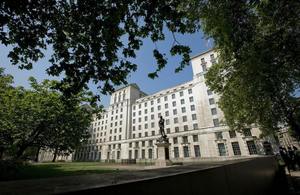Responding to Japanese nuclear crisis
Amongst those travelling to Japan to help with the recent crisis following the damage to the Fukushima nuclear power plant was a UK military Radiation Monitoring Team (RMT).

The Fukushima plant suffered serious damage and started releasing radioactive material following the devastating earthquake and tsunami that hit Japan on 11 March 2011.
In response to this incident, a three-man UK military RMT, augmented by a MOD health physicist, was deployed to the British Embassy in Tokyo.
The team’s mission was threefold: to monitor radiation levels within the vicinity of the British Embassy; to provide protection and radiation health advice to British Embassy personnel; and to provide reassurance to British Embassy staff and British nationals.
The military element of the team was provided by 26 Squadron RAF Regiment, based at RAF Honington, and consisted of Flight Lieutenant Trevor Slark-Hollis (team leader), Sergeant Owen Hughes and Corporal Jason Lovett.
The fourth team member was Geoffrey Todd, Staff Officer Nuclear Emergency Monitoring Organisation, from Defence Equipment and Support, who is a qualified health physicist.
The team arrived in Japan on 22 March 2011 and were met by the Defence Attaché, Captain Andy Eddney RN. They moved immediately to the British Embassy, located near the Imperial Palace, quickly established an operations room, and commenced sampling to ascertain initial radiation levels.
Whilst the British Embassy is around 250km from Fukushima, there was concern that personnel were at risk from radiation contamination. The team rapidly confirmed that ambient radiation levels did not pose any health risk to Embassy staff.
However, as a precaution, medical countermeasures, in the form of Potassium Iodate tablets, were made available.
Following initial air sampling, the RMT conducted a full ground deposition survey within the Embassy, with the samples tested on a Gamma Spectrometer. Whilst the results showed that the plume from the initial release from the reactor had passed over Tokyo, radiation levels were not at a level to pose any risk to health.
For the remainder of the deployment, points around the Embassy grounds were continually tested to ensure that the half-life decay rate was proceeding as expected. The team also took additional samples from around Tokyo, confirming that levels were nowhere near that which would cause concern for individuals’ health.
During the conduct of this work, the RMT liaised with other foreign embassies and their monitoring teams.
The team also devised plans to protect all UK personnel working within the Embassy in the event of a further release from Fukushima. This included advice on movement, individual protective equipment and collective protection.
As a further measure of reassurance, equipment and vehicles used on Embassy duties were monitored on a regular basis for contamination.
The team recovered to the UK on 21 April 2011 on completion of its mission. Flight Lieutenant Slark-Hollis said on his return:
The mission in Japan provided an excellent opportunity for 26 Squadron to conduct the tasks that it is currently prepared and equipped for as part of the UK Nuclear Emergency Response Organisation.
The experience gained will afford all members of the squadron a better understanding of the procedures required when dealing with a nuclear incident.
It is testament to the quality of the squadron personnel and the training they receive that they were able to deploy, at short notice, and provide an output to the same level expected when operating in the UK.
This is in spite of the difficulties associated with functioning in a country recovering from not only an earthquake but also a tsunami and a nuclear incident.
Sergeant Hughes added:
The work we did in Japan was extremely rewarding. In particular, our ability to quickly reassure British nationals that the risk to health from radioactive contamination was minimal was very satisfying.
The welcome from the Embassy staff was fantastic; they made us feel we were part of the Embassy team and went to great lengths to provide all possible assistance as and when required.
The squadron trains hard and attends many exercises in support of the UK Nuclear Emergency Response Organisation but to conduct our mission for real, in a foreign country and to see the importance of what we were doing, was a great experience.